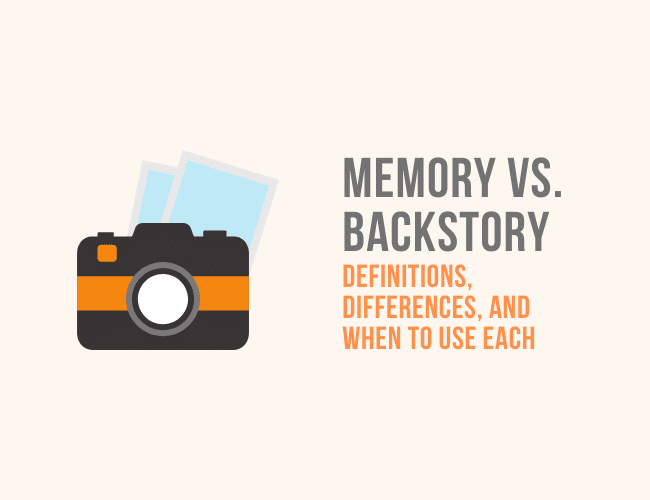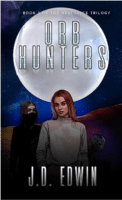The choices your fictional characters make within your story are shaped by their past, which means sometimes, you'll need to communicate to your reader events that happened before your story began. Not sure how? Try memory or character backstory to share the past in the present.

You are a deep, complex, and interesting individual, and so it goes without saying that you would want your characters to be as well—this is the heart of character development. But what makes someone complex and interesting?
The answer lies in their past—what they've been through makes them who they are today. It's that sense of history, personal history, that intrigues us. But you don't need a detailed backstory in every case. You can depend on formative events and key events from the character background to deepen your character creation.
Regardless of the type of story we're writing, we give our characters dimension by showing the readers their past through two plot devices—memory and backstory. Sometimes the difference between the two may not be clear, but knowing how to use them can make a world of difference in your characterization.
In this article, we'll break down the definition of backstory and memory, and look at how and when to use each.
Definition of Backstory in a Novel
Here's a backstory definition: it's objective information about a character's past. It's not filtered through the character's eyes, but may be conveyed by a third-person narrator. It may include both experiences the character can remember and information the character does not know.
How to Use Backstory
If a memory is a conversation, a backstory is a video clip. Rather than being told something by your character, you are watching them experience the event in question, perhaps like an old-timey black and white film strip.
A backstory is different from memory in the following ways:
1. Backstory is objective and accurate
The reader witnesses the backstory in question from an objective point of view, more like a documentary and less like an interview. A backstory is the reality of what took place in the character's past.
In the example mentioned above, a child would have a fond memory of his loving mother, but presented as a backstory, the author would also explain that this image of the woman is not shared by others, who found her unpleasant.
2. Backstory does not trigger emotion from the character
A backstory is an explanation to the reader, so whatever emotional response it solicits is from the reader and not the character.
3. Backstory may include information the character doesn't know
The character may not know everything in their backstory, but the reader might. A character might not realize that they were adopted, or that their best friend had always been their enemy, or that their lover is a secret double agent, or that they have magic in their blood … the list can go on and on.
The point is, the backstory can be a secret to the character themselves but still reveal their depth to the reader.
When to Use Character Backstory
Backstory is best used when you want your readers to know your characters better, perhaps even better than the characters know themselves. It can also be used to tease plot points to come later or help your readers understand why your character did something the way they did, even if the character themselves don't understand it.
In general, backstory works best when telling a story in third person omniscient.
Definition of Memory in a Novel
A memory is something (for example, childhood experiences or a piece of knowledge) that your character experienced or learned directly and can recall at a later point. Memory is filtered through the character who experienced the event and is shaped by their emotions and perceptions.
How to Use Memory
Think of a memory as something your character would tell you in a conversation. Character history in memory is personal and as a result, a memory has the following traits:
1. Memory is is subjective, or even inaccurate
A memory is how one person remembers something; how they remember it may not be how everyone remembers it. A child will cherish memories of her beautiful, loving mother, even if the rest of the world remembers her as a rude and unattractive person.
Childhood memories are often strong, but limited by their innocent (or not, depending on the character) perception of their ordinary lives.
In this way, a character's memory can be used to mislead the reader, or focus on something that isn't known to or noticed by other characters. It may reflect both their attitude toward life and their particular way of processing strong memories.
2. Memory is emotional
Memories directly trigger emotion. A character who is recalling a memory usually experiences a strong emotion following it. A young man recalling his recent wedding may be filled with happiness, whereas an old man recalling his wedding day may be filled with bittersweetness because his wife has passed.
If your character recalls a memory and it triggers no obvious emotion, then most likely the emotion is surprise—their own shock at their inability to react to the memory.
3. Memory is intimate
A memory is close to the heart. It is something your character holds close and most likely has some biases about. They cannot easily let it go or be convinced to change their mind about it, especially when they believe it is one of their fondest memories.
Characters will hold memories like treasures—or in the case of bad memories, vulnerabilities and insecurities.
When to Use Memory
Memories are best used when you want to relate something emotional about your character, such as provide a reason for a sudden change of emotion or introduce a specific and strong opinion. It lets your readers experience these emotions alongside the character and understand why they feel the way they do.
In general, memories work best when telling a story in first person or third person limited.
The Past in the Present: Character Backstory and Memory
The lives we live now are shaped by the events that came before, so you'll likely find your readers need to know information that happened before your story begins. Memories and backstory are two effective ways to share that information.
Don't feel that you need an entire backstory developed to use a small bit of backstory or memory effectively. Be specific about the key events, make sure it connects to the story arc, and you'll find you've written compelling character backstory and memory that resonates with the reader.
Do you prefer to use memories or backstories when developing your characters? Or which characters in fiction have the most compelling backstories? Share in the comments.
 Orb Hunters, book 3 of J. D. Edwin's Headspace trilogy is here! First, the gods abandoned the universe. Then, the champions and demigods waged war. Now, Kova has stumbled into the chaos, and she’s far out of her depth.
Orb Hunters, book 3 of J. D. Edwin's Headspace trilogy is here! First, the gods abandoned the universe. Then, the champions and demigods waged war. Now, Kova has stumbled into the chaos, and she’s far out of her depth.
Order your copy of Orb Hunters today!
PRACTICE
Pick one of your characters and write either a memory being recalled from first person or a backstory being told from third person, remembering to focus on emotion for the memory and facts for the backstory.
Need a prompt? Hannah is taking her kids to swim at the pool, something her own mother did with her once, one fateful summer.
Take fifteen minutes to write. When you're done, share your practice in the Pro Practice Workshop here, then give feedback to three other writers.
J. D. Edwin is a daydreamer and writer of fiction both long and short, usually in soft sci-fi or urban fantasy. Sign up for her newsletter for free articles on the writer life and updates on her novel, find her on Facebook and Twitter (@JDEdwinAuthor), or read one of her many short stories on Short Fiction Break literary magazine.
Hannah is taking her kids to swim at the pool, something her own mother did with her once, one fateful summer. It was the last time they went to the pool. Hannah mom, had passed away the next summer from a brain tumor. Hannah remembered how beautiful her mother was her golden blonde hair, rosy cheeks, and hazel green eyes. She would always looking into her mother’s eyes and know that ev we ything was gonna be ok. Well, the last time she looked into her mother’s eyes they didn’t tell her that. She was 10 years old when her mother passed it was the saddest day of her life. She never went back to the pool until today when she brought her kids. She wanted them to have memories of the pool like she did. Because what her kids didn’t know was she had been diagnosed with the same brain tumor disease as her mother.